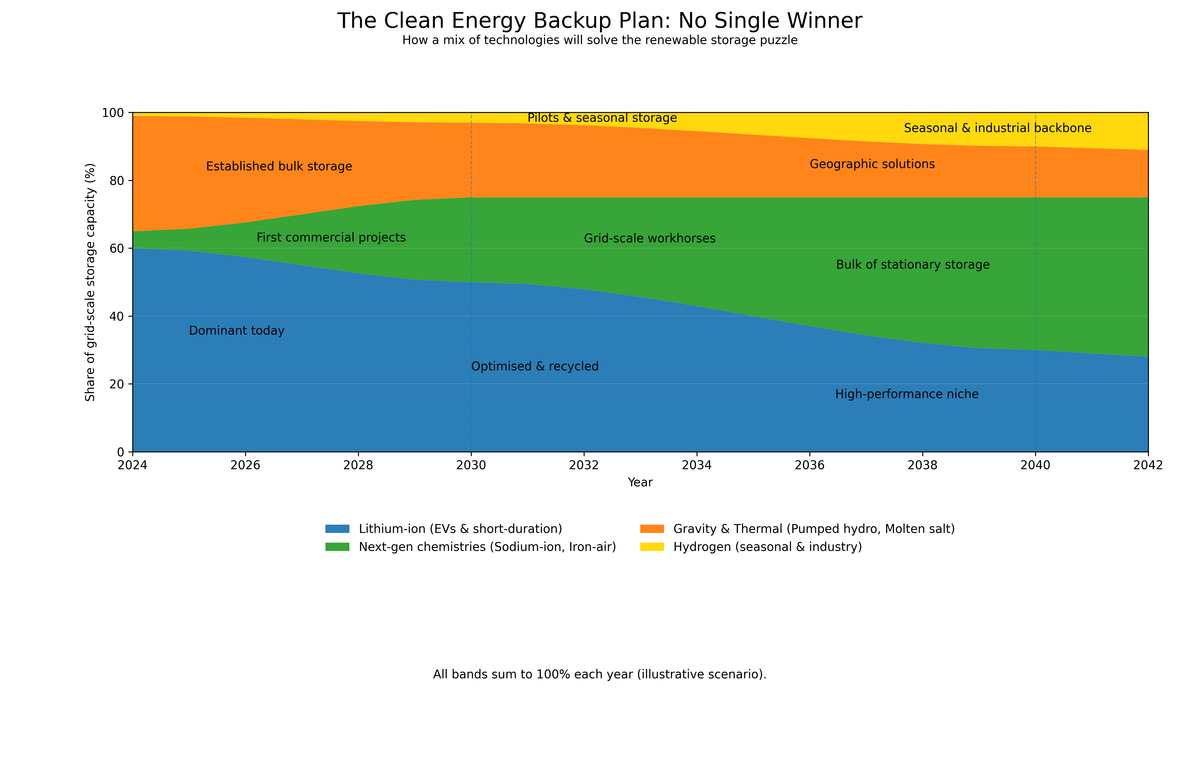How do you keep the lights and heating on at night when your solar powered?

Solar panels by day, wind turbines when they can be bothered: the poster children of clean energy. The trouble is, the panels only work when the sun shows up, and the turbine spins only when the weather co-operates. Which is precisely not when you actually want to boil the kettle.
The solution, of course, isn’t just hoarding a few rays of sunshine in a giant Duracell. It’s a mix: batteries to shift power across hours, grids to shuffle it across regions, and a few Heath Robinson contraptions to squeeze the demand into the right place at the right time. This is what grown-ups call demand response: persuading factories, offices, and even your dishwasher to shift their power use to when electricity is cheap and abundant. Less heroic than a shiny new battery, but often far cheaper. Wind, solar, hydro – they all work, just not always when you fancy a cuppa, hence the need for some juggling.
Grid dreams vs. gritty reality
On paper, the idea is gloriously simple. The sun is shining in Australia while it’s night in Europe. The wind is howling in Scotland when it’s dead calm in Spain. So why not just stitch the whole lot together with some high-voltage cable and swap electrons like Panini stickers?
Cue the usual objections:
- “Transmission losses!” — Yes, you do lose a smidge sending electricity long distances — on HVDC lines, losses are more like 3–4% per 1,000 km; for AC lines it can be nearer 6–10% (IEA ETSAP). Which sounds ghastly until you remember that shipping coal halfway across the world involves digging it up, loading it on a boat, sailing the boat for weeks, unloading it, and burning it in a wheezing turbine that chucks two-thirds of the energy away as waste heat. Suddenly, a couple of percent looks like a bargain.
- “Too expensive!” — Building high-voltage lines isn’t pocket change. But once you’ve strung them, the electricity flows with minimal ongoing cost. Transmission investment is often only about 10% of the delivered cost of electricity (World Bank). Contrast that with oil, gas, and coal, which demand an endless supply chain of ships, pipelines, trains and trucks, all guzzling money and diesel forever.
- “Never been done before!” — Actually, it has. The world already runs on massive transnational infrastructure: oil pipelines, LNG shipping, global coal routes. Fossil fuels have long crossed borders in huge volumes, with energy trade a central feature of global supply. Countries routinely import coal, oil or gas when domestic production is off or too expensive —BP’s Statistical Review of World Energy records large-scale trade movements of fossil fuels. If we managed to build all that for dirty fuels, we can certainly do it for clean ones.
- “Politics!” — True, energy security makes governments twitchy. But again, look at history: most of the world already depends on foreign fossil fuel suppliers, often the very ones they’re busy denouncing in Parliament (Ember, using IEA data, puts 74% of people in ‘net importer’ countries). Compared to that circus, agreeing to share electrons across borders should be the easy bit.
And then there’s the sheer time it takes. Permitting and building transnational transmission lines can drag on for a decade or more. NIMBYism (“Not In My Backyard”) has become a fine art: everyone wants clean power, provided the pylons don’t spoil their view. Which means shovel-ready projects can sit in limbo while lawyers argue about hedgerows.
So yes, grids are political, expensive, and technically fiddly. But unlike with coal and oil, you don’t have to keep paying for tankers and trains. Once you’ve strung up the cables, the power keeps flowing. And unlike fossil fuels, electricity doesn’t explode, leak, or need endless digging up. It just hums down the line, quietly doing its job — which makes the whole “too difficult” argument look suspiciously like an excuse.
Batteries: lovely until you look closely
The default storage darling is the lithium-ion battery – marvellous chemistry that made Elon Musk rich(er) and allows teenagers to watch TikTok for 12 hours straight. They also prop up solar homes and wind farms nicely, for a few hours at least.
Problems? Plenty.
- Lithium isn’t evenly sprinkled like salt. Most of it lurks in the so-called Lithium Triangle (Chile, Argentina, Bolivia), plus a healthy dollop in Australia (USGS). China, naturally, controls most of the refining and makes about three-quarters of all lithium-ion batteries in the world (IEA). That’s a supply chain that makes oil cartels look like a corner shop.
- Mining lithium often drains scarce water in arid desert regions, troubles local communities, and damages delicate ecosystems. Evaporative brine extraction can use millions of litres of fresh water per tonne, risks contaminating soil and water tables, and disturbs flora and fauna already living on the edge (Nature).
- Battery packs degrade over time — after 10-15 years many EV or storage batteries drop to 70-80% of their original capacity, meaning they’re far from eternal green saviours. They need replacing, or being repurposed, or recycled — which adds cost, complexity, and (if mishandled) environmental risk (Geotab; MIT modelling).
Still, if the alternative is rising seas, failing crops and an uninhabitable climate, then a handful of awkward mines and a global recycling programme start to look like the lesser inconvenience.
Storage beyond the lithium craze
But all this constant talk about lithium-ion batteries obscures a very important fact: lithium is not the only element in the periodic table. There are other tricks up the lab-coat sleeve:
- Sodium-ion: Basically table salt in a clever box. Cheaper, abundant, but a bit podgy and low on energy density. Fine for grid storage and short-range EVs (CATL).
- Iron-air: Rusts and de-rusts for a living. Dirt cheap, massive potential for multi-day storage (Form Energy).
- Solid-state lithium: Same old lithium, but posher. Supposed to be safer, less flammable, and longer-lasting. Toyota is teaming up with Idemitsu to commercialise solid-state batteries by 2027-28, working on solid electrolytes (like lithium sulphide) to boost range, speed up charging and improve safety.
- Hydrogen: Stores energy for months but wastes most of it along the way. Useful for lorries, steelworks, and politicians’ speeches (IRENA).
- Zinc, magnesium, aluminium, vanadium flow batteries: All having a go at being the next big thing, like indie bands from Sheffield. Vanadium redox flow batteries (VRFBs), for example, are under rapid development: they’re already being used for large-scale, long-duration energy storage, with improving materials, lifetimes, and cost curves.
The chemical search space is truly massive. We’re not limited to what we’ve already stumbled across — there’s a high likelihood that far better solutions exist (new electrolyte materials, novel redox couples, metal-air systems, organic batteries etc.), many of them undiscovered or still in labs. With enough R&D, regulation, and investment, some of these could arrive fast.
And let’s not forget old faithful: pumped hydro. Dig a hole, fill it with water, let gravity do the work — it’s one of the most mature large-scale storage technologies there is. According to the IEA’s Hydropower Special Market Report, pumped storage remains central to global hydropower forecasts through 2030, especially in places with suitable terrain (IEA).
But pumped hydro isn’t the only trick in the gravity-playbook. There are other gravity batteries emerging: solid gravity energy storage (weights, shafts, towers), liquid gravity setups, even rail- or shaft-based systems re-using old mines. These promise long lifespans, fewer chemical headaches, and no risk of electrolyte leaks.
Flywheels are also making a comeback. High-speed spinning rotors (often inside vacuums, on magnetic bearings) can store energy kinetically. They’re excellent for fast response, smoothing out short-term fluctuations in wind or solar.
Then there are heat batteries (thermal storage), phase change materials, molten salt, and other clever ways to hold onto energy in non-electrical form. These are especially useful where heat is the demand (space heating, industrial use) or for seasonal storage.
Gravity storage, flywheels, and thermal systems add to the mix. New gravity schemes (weights, mine shafts, rail cars), advanced flywheel materials, and innovations in heat storage (molten salt, phase-change materials) could complement batteries without the chemical baggage. These approaches aren’t science fiction — pilots are already running — and together they broaden the toolbox beyond just lithium and its cousins.
The wider picture
In short: storage is messy, grids are political, and lithium is a hot potato. But all these problems are engineering and governance issues – solvable with investment, better chemistry, recycling, and the occasional bit of international co-operation.
Compare that to global warming, which offers rising seas, famine, and the collapse of civilisation (IPCC AR6). On balance, solving batteries and grids looks like the easier job.
Where we’re heading
What’s likely to happen is a plural future:
- Lithium will continue powering your mobile and your Tesla.
- Sodium and zinc will sit quietly in shipping containers next to wind farms.
- Hydrogen will step in for heavy industry and seasonal balancing.
- And pumped hydro will chug away wherever there are mountains to flood.
Not perfect, not painless, but vastly better than sticking with coal and hoping for the best.
The Bottom Line:
The storage problem is real, but not fatal. The lithium problem is messy, but not insurmountable. The climate problem, on the other hand, is catastrophic if we ignore it. So yes, let’s build better batteries, smarter grids, and recycle the hell out of everything. Because the alternative is to discover just how warm the water gets before we’re all cooked.




